Assignment about Nursing Burnout
VerifiedAdded on 2022/08/28
|14
|4338
|17
Assignment
AI Summary
Contribute Materials
Your contribution can guide someone’s learning journey. Share your
documents today.
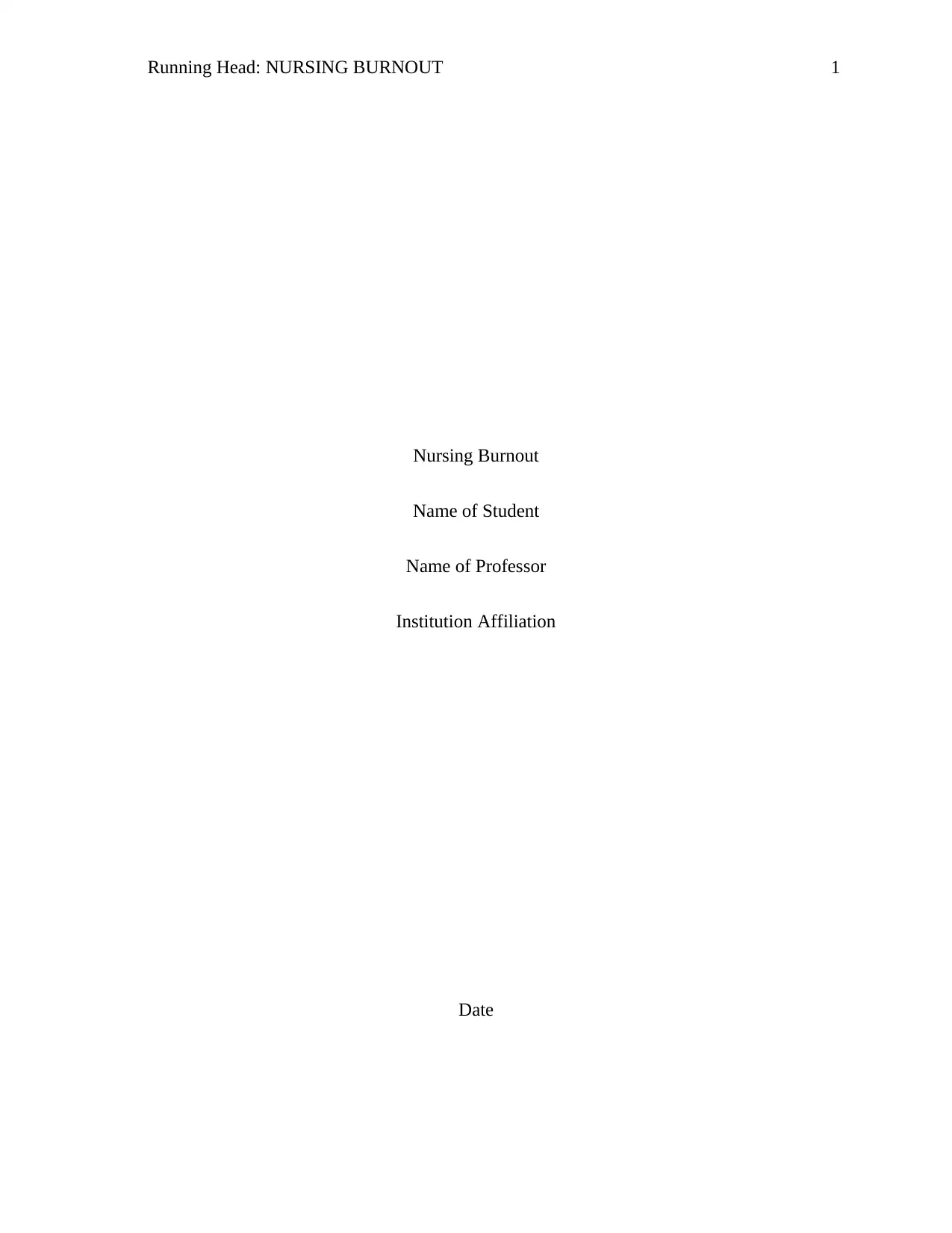
Running Head: NURSING BURNOUT 1
Nursing Burnout
Name of Student
Name of Professor
Institution Affiliation
Date
Nursing Burnout
Name of Student
Name of Professor
Institution Affiliation
Date
Secure Best Marks with AI Grader
Need help grading? Try our AI Grader for instant feedback on your assignments.
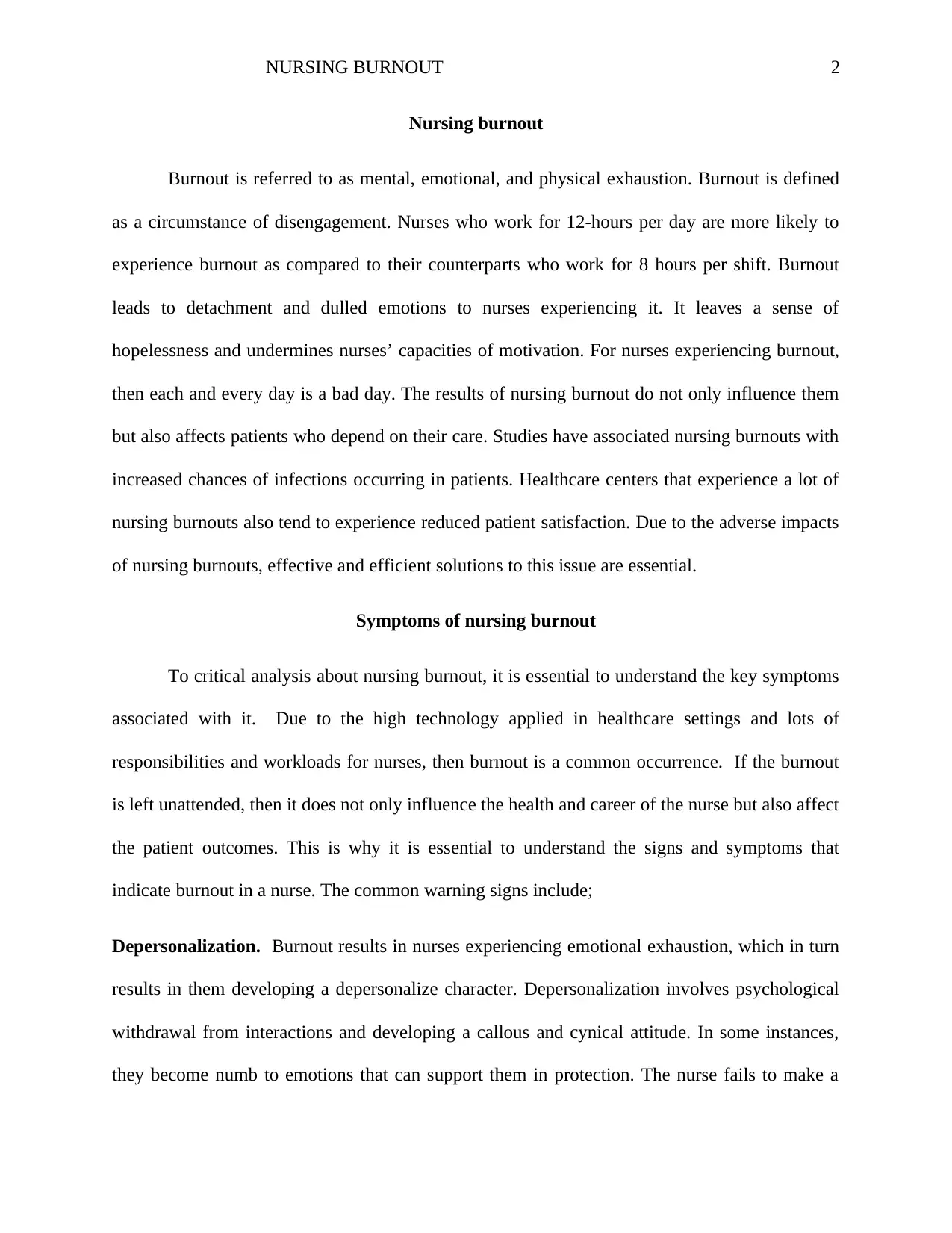
NURSING BURNOUT 2
Nursing burnout
Burnout is referred to as mental, emotional, and physical exhaustion. Burnout is defined
as a circumstance of disengagement. Nurses who work for 12-hours per day are more likely to
experience burnout as compared to their counterparts who work for 8 hours per shift. Burnout
leads to detachment and dulled emotions to nurses experiencing it. It leaves a sense of
hopelessness and undermines nurses’ capacities of motivation. For nurses experiencing burnout,
then each and every day is a bad day. The results of nursing burnout do not only influence them
but also affects patients who depend on their care. Studies have associated nursing burnouts with
increased chances of infections occurring in patients. Healthcare centers that experience a lot of
nursing burnouts also tend to experience reduced patient satisfaction. Due to the adverse impacts
of nursing burnouts, effective and efficient solutions to this issue are essential.
Symptoms of nursing burnout
To critical analysis about nursing burnout, it is essential to understand the key symptoms
associated with it. Due to the high technology applied in healthcare settings and lots of
responsibilities and workloads for nurses, then burnout is a common occurrence. If the burnout
is left unattended, then it does not only influence the health and career of the nurse but also affect
the patient outcomes. This is why it is essential to understand the signs and symptoms that
indicate burnout in a nurse. The common warning signs include;
Depersonalization. Burnout results in nurses experiencing emotional exhaustion, which in turn
results in them developing a depersonalize character. Depersonalization involves psychological
withdrawal from interactions and developing a callous and cynical attitude. In some instances,
they become numb to emotions that can support them in protection. The nurse fails to make a
Nursing burnout
Burnout is referred to as mental, emotional, and physical exhaustion. Burnout is defined
as a circumstance of disengagement. Nurses who work for 12-hours per day are more likely to
experience burnout as compared to their counterparts who work for 8 hours per shift. Burnout
leads to detachment and dulled emotions to nurses experiencing it. It leaves a sense of
hopelessness and undermines nurses’ capacities of motivation. For nurses experiencing burnout,
then each and every day is a bad day. The results of nursing burnout do not only influence them
but also affects patients who depend on their care. Studies have associated nursing burnouts with
increased chances of infections occurring in patients. Healthcare centers that experience a lot of
nursing burnouts also tend to experience reduced patient satisfaction. Due to the adverse impacts
of nursing burnouts, effective and efficient solutions to this issue are essential.
Symptoms of nursing burnout
To critical analysis about nursing burnout, it is essential to understand the key symptoms
associated with it. Due to the high technology applied in healthcare settings and lots of
responsibilities and workloads for nurses, then burnout is a common occurrence. If the burnout
is left unattended, then it does not only influence the health and career of the nurse but also affect
the patient outcomes. This is why it is essential to understand the signs and symptoms that
indicate burnout in a nurse. The common warning signs include;
Depersonalization. Burnout results in nurses experiencing emotional exhaustion, which in turn
results in them developing a depersonalize character. Depersonalization involves psychological
withdrawal from interactions and developing a callous and cynical attitude. In some instances,
they become numb to emotions that can support them in protection. The nurse fails to make a
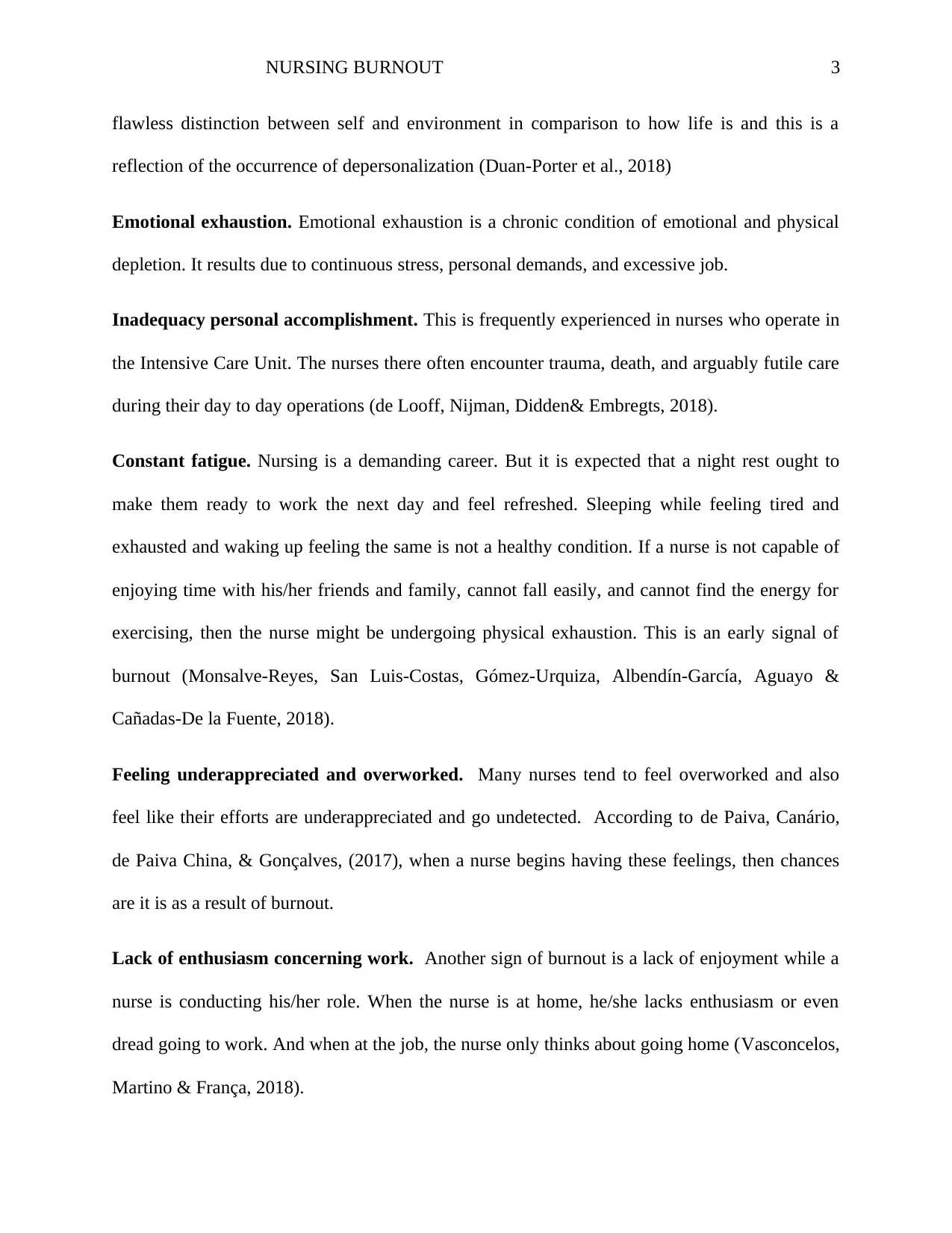
NURSING BURNOUT 3
flawless distinction between self and environment in comparison to how life is and this is a
reflection of the occurrence of depersonalization (Duan-Porter et al., 2018)
Emotional exhaustion. Emotional exhaustion is a chronic condition of emotional and physical
depletion. It results due to continuous stress, personal demands, and excessive job.
Inadequacy personal accomplishment. This is frequently experienced in nurses who operate in
the Intensive Care Unit. The nurses there often encounter trauma, death, and arguably futile care
during their day to day operations (de Looff, Nijman, Didden& Embregts, 2018).
Constant fatigue. Nursing is a demanding career. But it is expected that a night rest ought to
make them ready to work the next day and feel refreshed. Sleeping while feeling tired and
exhausted and waking up feeling the same is not a healthy condition. If a nurse is not capable of
enjoying time with his/her friends and family, cannot fall easily, and cannot find the energy for
exercising, then the nurse might be undergoing physical exhaustion. This is an early signal of
burnout (Monsalve-Reyes, San Luis-Costas, Gómez-Urquiza, Albendín-García, Aguayo &
Cañadas-De la Fuente, 2018).
Feeling underappreciated and overworked. Many nurses tend to feel overworked and also
feel like their efforts are underappreciated and go undetected. According to de Paiva, Canário,
de Paiva China, & Gonçalves, (2017), when a nurse begins having these feelings, then chances
are it is as a result of burnout.
Lack of enthusiasm concerning work. Another sign of burnout is a lack of enjoyment while a
nurse is conducting his/her role. When the nurse is at home, he/she lacks enthusiasm or even
dread going to work. And when at the job, the nurse only thinks about going home (Vasconcelos,
Martino & França, 2018).
flawless distinction between self and environment in comparison to how life is and this is a
reflection of the occurrence of depersonalization (Duan-Porter et al., 2018)
Emotional exhaustion. Emotional exhaustion is a chronic condition of emotional and physical
depletion. It results due to continuous stress, personal demands, and excessive job.
Inadequacy personal accomplishment. This is frequently experienced in nurses who operate in
the Intensive Care Unit. The nurses there often encounter trauma, death, and arguably futile care
during their day to day operations (de Looff, Nijman, Didden& Embregts, 2018).
Constant fatigue. Nursing is a demanding career. But it is expected that a night rest ought to
make them ready to work the next day and feel refreshed. Sleeping while feeling tired and
exhausted and waking up feeling the same is not a healthy condition. If a nurse is not capable of
enjoying time with his/her friends and family, cannot fall easily, and cannot find the energy for
exercising, then the nurse might be undergoing physical exhaustion. This is an early signal of
burnout (Monsalve-Reyes, San Luis-Costas, Gómez-Urquiza, Albendín-García, Aguayo &
Cañadas-De la Fuente, 2018).
Feeling underappreciated and overworked. Many nurses tend to feel overworked and also
feel like their efforts are underappreciated and go undetected. According to de Paiva, Canário,
de Paiva China, & Gonçalves, (2017), when a nurse begins having these feelings, then chances
are it is as a result of burnout.
Lack of enthusiasm concerning work. Another sign of burnout is a lack of enjoyment while a
nurse is conducting his/her role. When the nurse is at home, he/she lacks enthusiasm or even
dread going to work. And when at the job, the nurse only thinks about going home (Vasconcelos,
Martino & França, 2018).
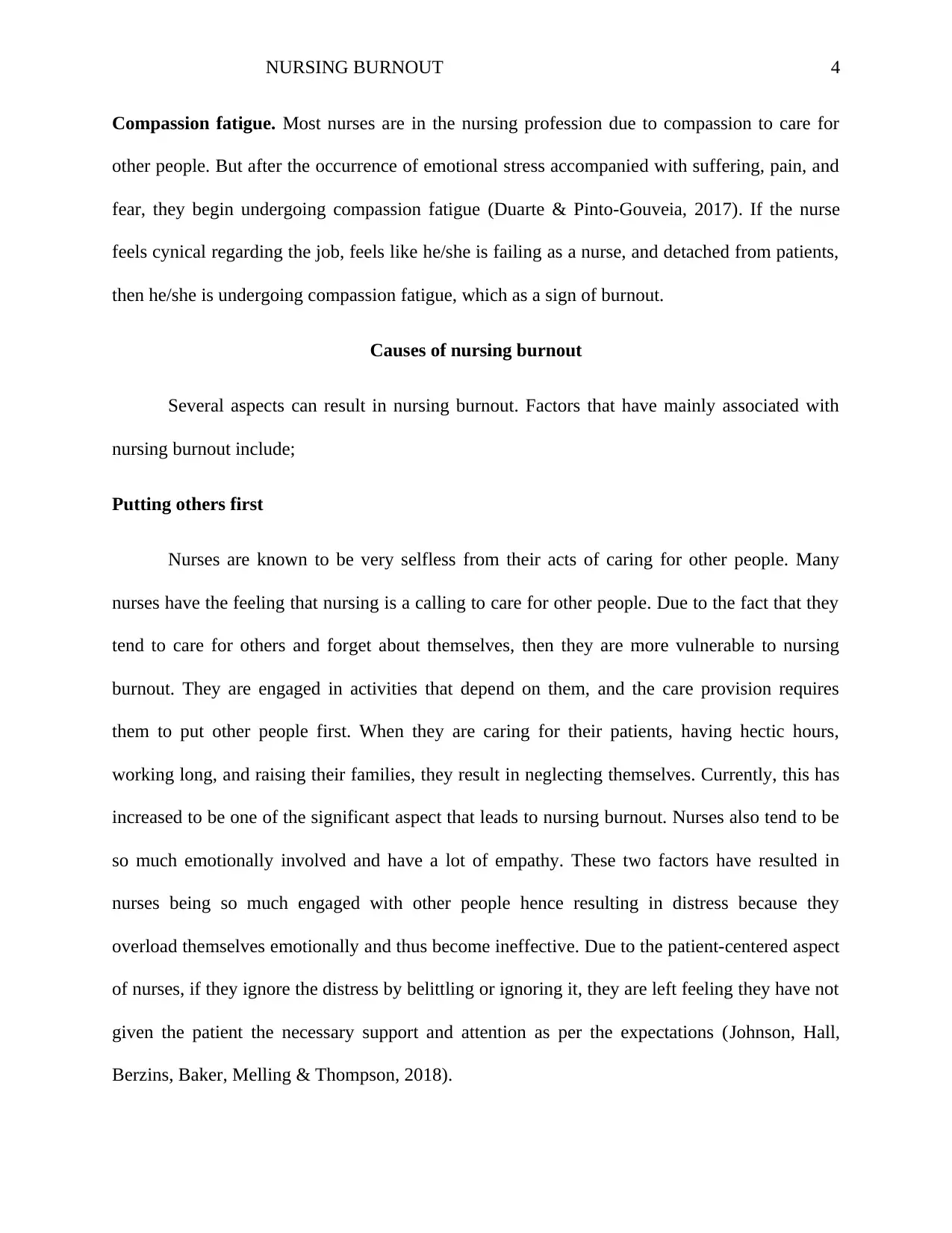
NURSING BURNOUT 4
Compassion fatigue. Most nurses are in the nursing profession due to compassion to care for
other people. But after the occurrence of emotional stress accompanied with suffering, pain, and
fear, they begin undergoing compassion fatigue (Duarte & Pinto-Gouveia, 2017). If the nurse
feels cynical regarding the job, feels like he/she is failing as a nurse, and detached from patients,
then he/she is undergoing compassion fatigue, which as a sign of burnout.
Causes of nursing burnout
Several aspects can result in nursing burnout. Factors that have mainly associated with
nursing burnout include;
Putting others first
Nurses are known to be very selfless from their acts of caring for other people. Many
nurses have the feeling that nursing is a calling to care for other people. Due to the fact that they
tend to care for others and forget about themselves, then they are more vulnerable to nursing
burnout. They are engaged in activities that depend on them, and the care provision requires
them to put other people first. When they are caring for their patients, having hectic hours,
working long, and raising their families, they result in neglecting themselves. Currently, this has
increased to be one of the significant aspect that leads to nursing burnout. Nurses also tend to be
so much emotionally involved and have a lot of empathy. These two factors have resulted in
nurses being so much engaged with other people hence resulting in distress because they
overload themselves emotionally and thus become ineffective. Due to the patient-centered aspect
of nurses, if they ignore the distress by belittling or ignoring it, they are left feeling they have not
given the patient the necessary support and attention as per the expectations (Johnson, Hall,
Berzins, Baker, Melling & Thompson, 2018).
Compassion fatigue. Most nurses are in the nursing profession due to compassion to care for
other people. But after the occurrence of emotional stress accompanied with suffering, pain, and
fear, they begin undergoing compassion fatigue (Duarte & Pinto-Gouveia, 2017). If the nurse
feels cynical regarding the job, feels like he/she is failing as a nurse, and detached from patients,
then he/she is undergoing compassion fatigue, which as a sign of burnout.
Causes of nursing burnout
Several aspects can result in nursing burnout. Factors that have mainly associated with
nursing burnout include;
Putting others first
Nurses are known to be very selfless from their acts of caring for other people. Many
nurses have the feeling that nursing is a calling to care for other people. Due to the fact that they
tend to care for others and forget about themselves, then they are more vulnerable to nursing
burnout. They are engaged in activities that depend on them, and the care provision requires
them to put other people first. When they are caring for their patients, having hectic hours,
working long, and raising their families, they result in neglecting themselves. Currently, this has
increased to be one of the significant aspect that leads to nursing burnout. Nurses also tend to be
so much emotionally involved and have a lot of empathy. These two factors have resulted in
nurses being so much engaged with other people hence resulting in distress because they
overload themselves emotionally and thus become ineffective. Due to the patient-centered aspect
of nurses, if they ignore the distress by belittling or ignoring it, they are left feeling they have not
given the patient the necessary support and attention as per the expectations (Johnson, Hall,
Berzins, Baker, Melling & Thompson, 2018).
Secure Best Marks with AI Grader
Need help grading? Try our AI Grader for instant feedback on your assignments.
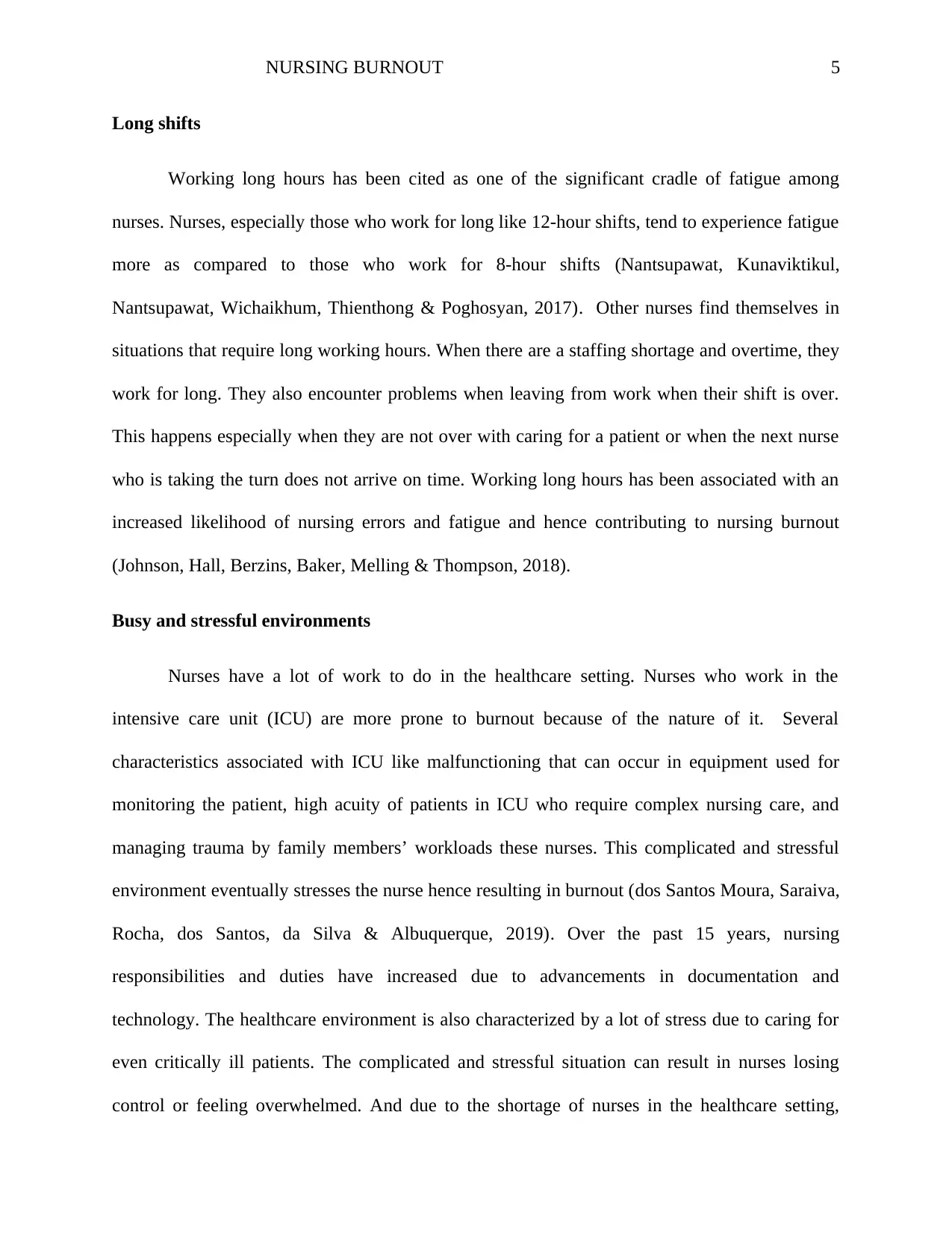
NURSING BURNOUT 5
Long shifts
Working long hours has been cited as one of the significant cradle of fatigue among
nurses. Nurses, especially those who work for long like 12-hour shifts, tend to experience fatigue
more as compared to those who work for 8-hour shifts (Nantsupawat, Kunaviktikul,
Nantsupawat, Wichaikhum, Thienthong & Poghosyan, 2017). Other nurses find themselves in
situations that require long working hours. When there are a staffing shortage and overtime, they
work for long. They also encounter problems when leaving from work when their shift is over.
This happens especially when they are not over with caring for a patient or when the next nurse
who is taking the turn does not arrive on time. Working long hours has been associated with an
increased likelihood of nursing errors and fatigue and hence contributing to nursing burnout
(Johnson, Hall, Berzins, Baker, Melling & Thompson, 2018).
Busy and stressful environments
Nurses have a lot of work to do in the healthcare setting. Nurses who work in the
intensive care unit (ICU) are more prone to burnout because of the nature of it. Several
characteristics associated with ICU like malfunctioning that can occur in equipment used for
monitoring the patient, high acuity of patients in ICU who require complex nursing care, and
managing trauma by family members’ workloads these nurses. This complicated and stressful
environment eventually stresses the nurse hence resulting in burnout (dos Santos Moura, Saraiva,
Rocha, dos Santos, da Silva & Albuquerque, 2019). Over the past 15 years, nursing
responsibilities and duties have increased due to advancements in documentation and
technology. The healthcare environment is also characterized by a lot of stress due to caring for
even critically ill patients. The complicated and stressful situation can result in nurses losing
control or feeling overwhelmed. And due to the shortage of nurses in the healthcare setting,
Long shifts
Working long hours has been cited as one of the significant cradle of fatigue among
nurses. Nurses, especially those who work for long like 12-hour shifts, tend to experience fatigue
more as compared to those who work for 8-hour shifts (Nantsupawat, Kunaviktikul,
Nantsupawat, Wichaikhum, Thienthong & Poghosyan, 2017). Other nurses find themselves in
situations that require long working hours. When there are a staffing shortage and overtime, they
work for long. They also encounter problems when leaving from work when their shift is over.
This happens especially when they are not over with caring for a patient or when the next nurse
who is taking the turn does not arrive on time. Working long hours has been associated with an
increased likelihood of nursing errors and fatigue and hence contributing to nursing burnout
(Johnson, Hall, Berzins, Baker, Melling & Thompson, 2018).
Busy and stressful environments
Nurses have a lot of work to do in the healthcare setting. Nurses who work in the
intensive care unit (ICU) are more prone to burnout because of the nature of it. Several
characteristics associated with ICU like malfunctioning that can occur in equipment used for
monitoring the patient, high acuity of patients in ICU who require complex nursing care, and
managing trauma by family members’ workloads these nurses. This complicated and stressful
environment eventually stresses the nurse hence resulting in burnout (dos Santos Moura, Saraiva,
Rocha, dos Santos, da Silva & Albuquerque, 2019). Over the past 15 years, nursing
responsibilities and duties have increased due to advancements in documentation and
technology. The healthcare environment is also characterized by a lot of stress due to caring for
even critically ill patients. The complicated and stressful situation can result in nurses losing
control or feeling overwhelmed. And due to the shortage of nurses in the healthcare setting,
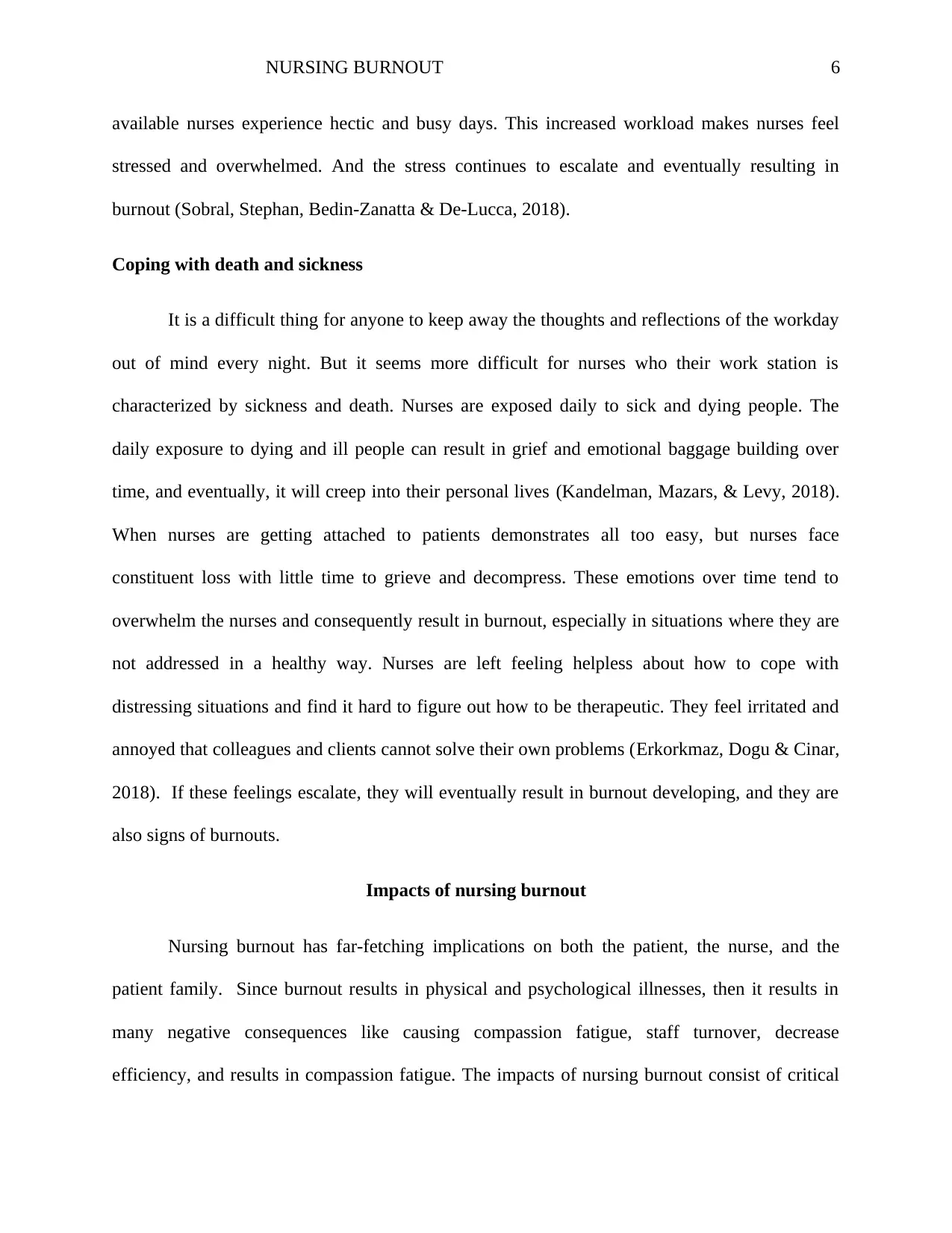
NURSING BURNOUT 6
available nurses experience hectic and busy days. This increased workload makes nurses feel
stressed and overwhelmed. And the stress continues to escalate and eventually resulting in
burnout (Sobral, Stephan, Bedin-Zanatta & De-Lucca, 2018).
Coping with death and sickness
It is a difficult thing for anyone to keep away the thoughts and reflections of the workday
out of mind every night. But it seems more difficult for nurses who their work station is
characterized by sickness and death. Nurses are exposed daily to sick and dying people. The
daily exposure to dying and ill people can result in grief and emotional baggage building over
time, and eventually, it will creep into their personal lives (Kandelman, Mazars, & Levy, 2018).
When nurses are getting attached to patients demonstrates all too easy, but nurses face
constituent loss with little time to grieve and decompress. These emotions over time tend to
overwhelm the nurses and consequently result in burnout, especially in situations where they are
not addressed in a healthy way. Nurses are left feeling helpless about how to cope with
distressing situations and find it hard to figure out how to be therapeutic. They feel irritated and
annoyed that colleagues and clients cannot solve their own problems (Erkorkmaz, Dogu & Cinar,
2018). If these feelings escalate, they will eventually result in burnout developing, and they are
also signs of burnouts.
Impacts of nursing burnout
Nursing burnout has far-fetching implications on both the patient, the nurse, and the
patient family. Since burnout results in physical and psychological illnesses, then it results in
many negative consequences like causing compassion fatigue, staff turnover, decrease
efficiency, and results in compassion fatigue. The impacts of nursing burnout consist of critical
available nurses experience hectic and busy days. This increased workload makes nurses feel
stressed and overwhelmed. And the stress continues to escalate and eventually resulting in
burnout (Sobral, Stephan, Bedin-Zanatta & De-Lucca, 2018).
Coping with death and sickness
It is a difficult thing for anyone to keep away the thoughts and reflections of the workday
out of mind every night. But it seems more difficult for nurses who their work station is
characterized by sickness and death. Nurses are exposed daily to sick and dying people. The
daily exposure to dying and ill people can result in grief and emotional baggage building over
time, and eventually, it will creep into their personal lives (Kandelman, Mazars, & Levy, 2018).
When nurses are getting attached to patients demonstrates all too easy, but nurses face
constituent loss with little time to grieve and decompress. These emotions over time tend to
overwhelm the nurses and consequently result in burnout, especially in situations where they are
not addressed in a healthy way. Nurses are left feeling helpless about how to cope with
distressing situations and find it hard to figure out how to be therapeutic. They feel irritated and
annoyed that colleagues and clients cannot solve their own problems (Erkorkmaz, Dogu & Cinar,
2018). If these feelings escalate, they will eventually result in burnout developing, and they are
also signs of burnouts.
Impacts of nursing burnout
Nursing burnout has far-fetching implications on both the patient, the nurse, and the
patient family. Since burnout results in physical and psychological illnesses, then it results in
many negative consequences like causing compassion fatigue, staff turnover, decrease
efficiency, and results in compassion fatigue. The impacts of nursing burnout consist of critical
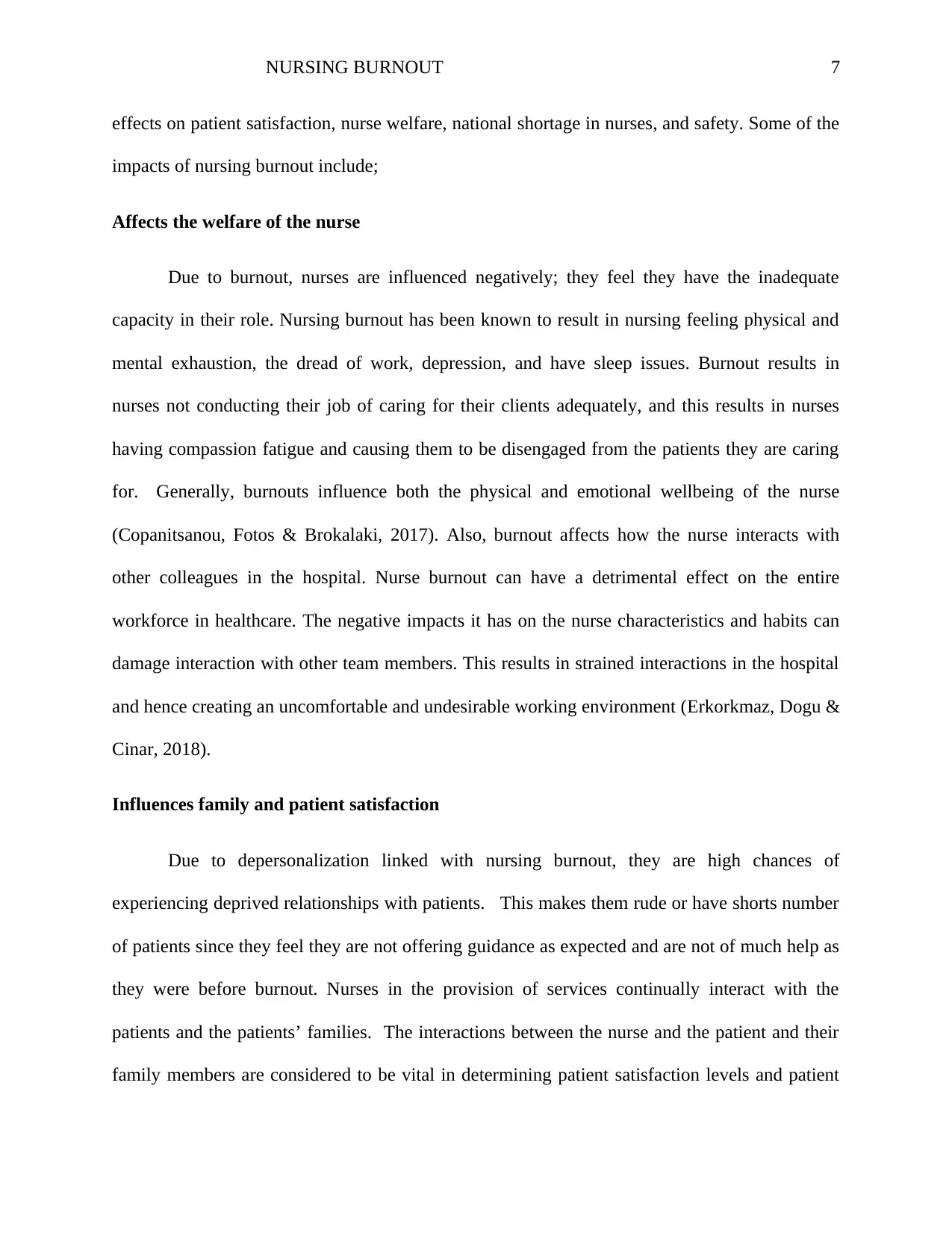
NURSING BURNOUT 7
effects on patient satisfaction, nurse welfare, national shortage in nurses, and safety. Some of the
impacts of nursing burnout include;
Affects the welfare of the nurse
Due to burnout, nurses are influenced negatively; they feel they have the inadequate
capacity in their role. Nursing burnout has been known to result in nursing feeling physical and
mental exhaustion, the dread of work, depression, and have sleep issues. Burnout results in
nurses not conducting their job of caring for their clients adequately, and this results in nurses
having compassion fatigue and causing them to be disengaged from the patients they are caring
for. Generally, burnouts influence both the physical and emotional wellbeing of the nurse
(Copanitsanou, Fotos & Brokalaki, 2017). Also, burnout affects how the nurse interacts with
other colleagues in the hospital. Nurse burnout can have a detrimental effect on the entire
workforce in healthcare. The negative impacts it has on the nurse characteristics and habits can
damage interaction with other team members. This results in strained interactions in the hospital
and hence creating an uncomfortable and undesirable working environment (Erkorkmaz, Dogu &
Cinar, 2018).
Influences family and patient satisfaction
Due to depersonalization linked with nursing burnout, they are high chances of
experiencing deprived relationships with patients. This makes them rude or have shorts number
of patients since they feel they are not offering guidance as expected and are not of much help as
they were before burnout. Nurses in the provision of services continually interact with the
patients and the patients’ families. The interactions between the nurse and the patient and their
family members are considered to be vital in determining patient satisfaction levels and patient
effects on patient satisfaction, nurse welfare, national shortage in nurses, and safety. Some of the
impacts of nursing burnout include;
Affects the welfare of the nurse
Due to burnout, nurses are influenced negatively; they feel they have the inadequate
capacity in their role. Nursing burnout has been known to result in nursing feeling physical and
mental exhaustion, the dread of work, depression, and have sleep issues. Burnout results in
nurses not conducting their job of caring for their clients adequately, and this results in nurses
having compassion fatigue and causing them to be disengaged from the patients they are caring
for. Generally, burnouts influence both the physical and emotional wellbeing of the nurse
(Copanitsanou, Fotos & Brokalaki, 2017). Also, burnout affects how the nurse interacts with
other colleagues in the hospital. Nurse burnout can have a detrimental effect on the entire
workforce in healthcare. The negative impacts it has on the nurse characteristics and habits can
damage interaction with other team members. This results in strained interactions in the hospital
and hence creating an uncomfortable and undesirable working environment (Erkorkmaz, Dogu &
Cinar, 2018).
Influences family and patient satisfaction
Due to depersonalization linked with nursing burnout, they are high chances of
experiencing deprived relationships with patients. This makes them rude or have shorts number
of patients since they feel they are not offering guidance as expected and are not of much help as
they were before burnout. Nurses in the provision of services continually interact with the
patients and the patients’ families. The interactions between the nurse and the patient and their
family members are considered to be vital in determining patient satisfaction levels and patient
Paraphrase This Document
Need a fresh take? Get an instant paraphrase of this document with our AI Paraphraser
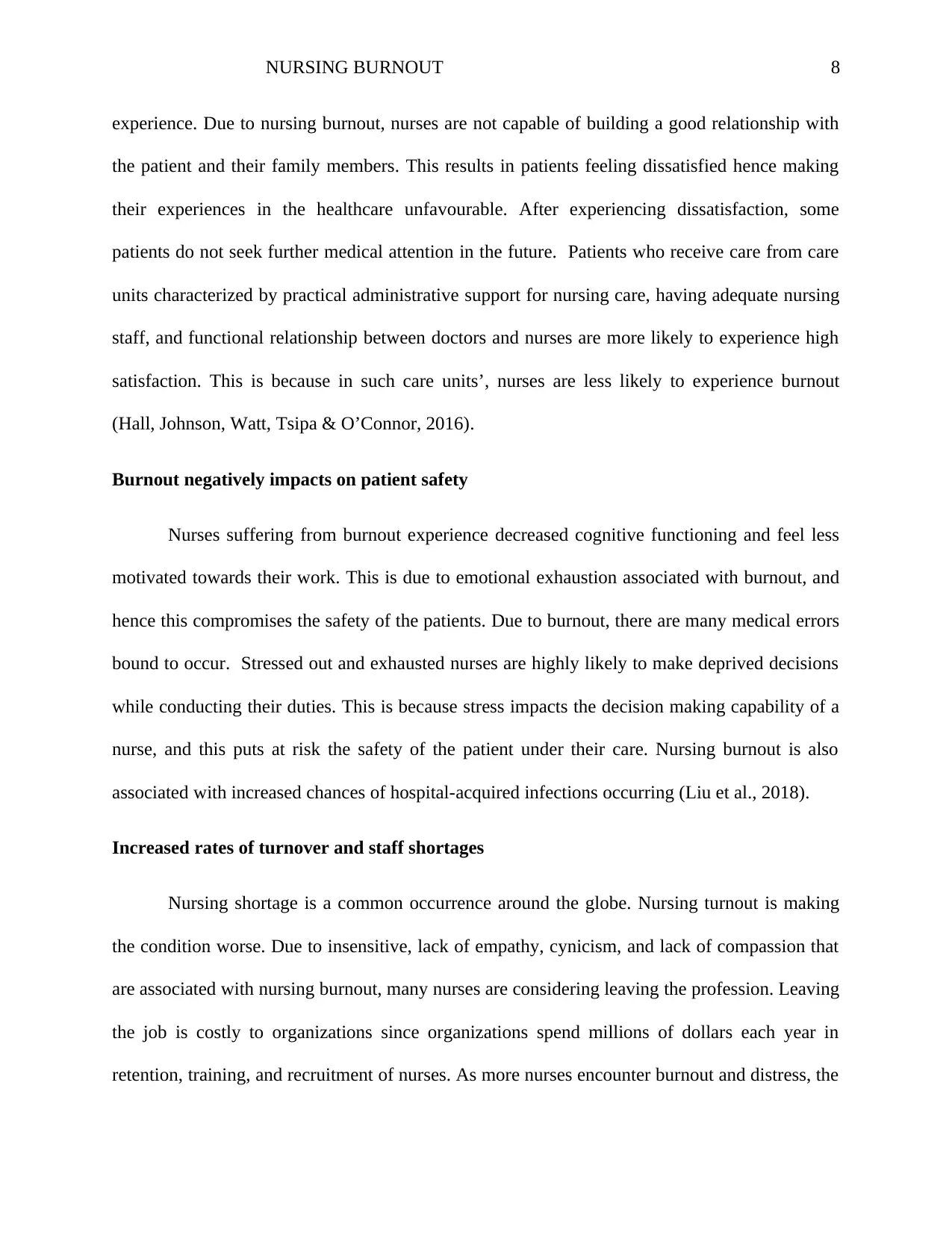
NURSING BURNOUT 8
experience. Due to nursing burnout, nurses are not capable of building a good relationship with
the patient and their family members. This results in patients feeling dissatisfied hence making
their experiences in the healthcare unfavourable. After experiencing dissatisfaction, some
patients do not seek further medical attention in the future. Patients who receive care from care
units characterized by practical administrative support for nursing care, having adequate nursing
staff, and functional relationship between doctors and nurses are more likely to experience high
satisfaction. This is because in such care units’, nurses are less likely to experience burnout
(Hall, Johnson, Watt, Tsipa & O’Connor, 2016).
Burnout negatively impacts on patient safety
Nurses suffering from burnout experience decreased cognitive functioning and feel less
motivated towards their work. This is due to emotional exhaustion associated with burnout, and
hence this compromises the safety of the patients. Due to burnout, there are many medical errors
bound to occur. Stressed out and exhausted nurses are highly likely to make deprived decisions
while conducting their duties. This is because stress impacts the decision making capability of a
nurse, and this puts at risk the safety of the patient under their care. Nursing burnout is also
associated with increased chances of hospital-acquired infections occurring (Liu et al., 2018).
Increased rates of turnover and staff shortages
Nursing shortage is a common occurrence around the globe. Nursing turnout is making
the condition worse. Due to insensitive, lack of empathy, cynicism, and lack of compassion that
are associated with nursing burnout, many nurses are considering leaving the profession. Leaving
the job is costly to organizations since organizations spend millions of dollars each year in
retention, training, and recruitment of nurses. As more nurses encounter burnout and distress, the
experience. Due to nursing burnout, nurses are not capable of building a good relationship with
the patient and their family members. This results in patients feeling dissatisfied hence making
their experiences in the healthcare unfavourable. After experiencing dissatisfaction, some
patients do not seek further medical attention in the future. Patients who receive care from care
units characterized by practical administrative support for nursing care, having adequate nursing
staff, and functional relationship between doctors and nurses are more likely to experience high
satisfaction. This is because in such care units’, nurses are less likely to experience burnout
(Hall, Johnson, Watt, Tsipa & O’Connor, 2016).
Burnout negatively impacts on patient safety
Nurses suffering from burnout experience decreased cognitive functioning and feel less
motivated towards their work. This is due to emotional exhaustion associated with burnout, and
hence this compromises the safety of the patients. Due to burnout, there are many medical errors
bound to occur. Stressed out and exhausted nurses are highly likely to make deprived decisions
while conducting their duties. This is because stress impacts the decision making capability of a
nurse, and this puts at risk the safety of the patient under their care. Nursing burnout is also
associated with increased chances of hospital-acquired infections occurring (Liu et al., 2018).
Increased rates of turnover and staff shortages
Nursing shortage is a common occurrence around the globe. Nursing turnout is making
the condition worse. Due to insensitive, lack of empathy, cynicism, and lack of compassion that
are associated with nursing burnout, many nurses are considering leaving the profession. Leaving
the job is costly to organizations since organizations spend millions of dollars each year in
retention, training, and recruitment of nurses. As more nurses encounter burnout and distress, the
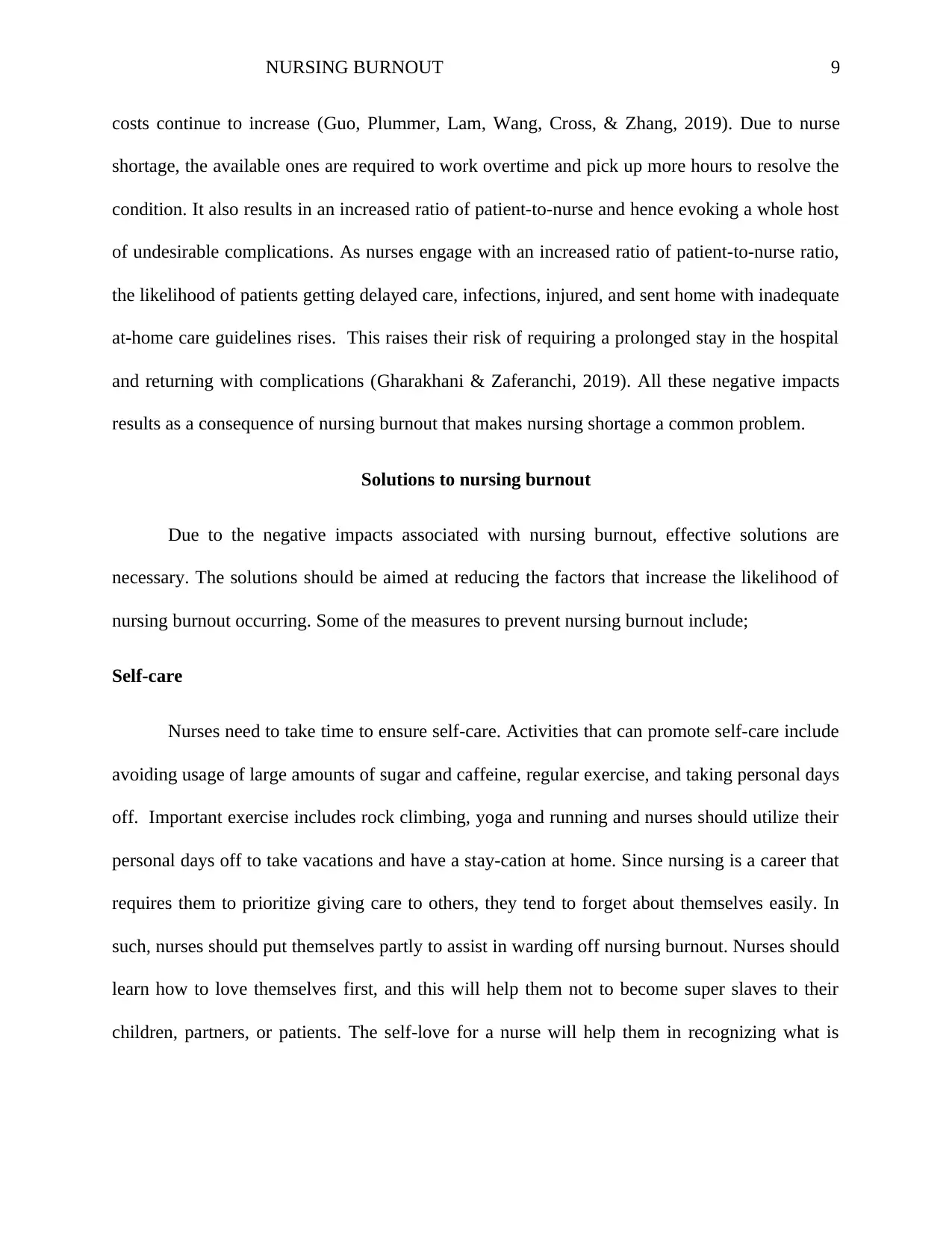
NURSING BURNOUT 9
costs continue to increase (Guo, Plummer, Lam, Wang, Cross, & Zhang, 2019). Due to nurse
shortage, the available ones are required to work overtime and pick up more hours to resolve the
condition. It also results in an increased ratio of patient-to-nurse and hence evoking a whole host
of undesirable complications. As nurses engage with an increased ratio of patient-to-nurse ratio,
the likelihood of patients getting delayed care, infections, injured, and sent home with inadequate
at-home care guidelines rises. This raises their risk of requiring a prolonged stay in the hospital
and returning with complications (Gharakhani & Zaferanchi, 2019). All these negative impacts
results as a consequence of nursing burnout that makes nursing shortage a common problem.
Solutions to nursing burnout
Due to the negative impacts associated with nursing burnout, effective solutions are
necessary. The solutions should be aimed at reducing the factors that increase the likelihood of
nursing burnout occurring. Some of the measures to prevent nursing burnout include;
Self-care
Nurses need to take time to ensure self-care. Activities that can promote self-care include
avoiding usage of large amounts of sugar and caffeine, regular exercise, and taking personal days
off. Important exercise includes rock climbing, yoga and running and nurses should utilize their
personal days off to take vacations and have a stay-cation at home. Since nursing is a career that
requires them to prioritize giving care to others, they tend to forget about themselves easily. In
such, nurses should put themselves partly to assist in warding off nursing burnout. Nurses should
learn how to love themselves first, and this will help them not to become super slaves to their
children, partners, or patients. The self-love for a nurse will help them in recognizing what is
costs continue to increase (Guo, Plummer, Lam, Wang, Cross, & Zhang, 2019). Due to nurse
shortage, the available ones are required to work overtime and pick up more hours to resolve the
condition. It also results in an increased ratio of patient-to-nurse and hence evoking a whole host
of undesirable complications. As nurses engage with an increased ratio of patient-to-nurse ratio,
the likelihood of patients getting delayed care, infections, injured, and sent home with inadequate
at-home care guidelines rises. This raises their risk of requiring a prolonged stay in the hospital
and returning with complications (Gharakhani & Zaferanchi, 2019). All these negative impacts
results as a consequence of nursing burnout that makes nursing shortage a common problem.
Solutions to nursing burnout
Due to the negative impacts associated with nursing burnout, effective solutions are
necessary. The solutions should be aimed at reducing the factors that increase the likelihood of
nursing burnout occurring. Some of the measures to prevent nursing burnout include;
Self-care
Nurses need to take time to ensure self-care. Activities that can promote self-care include
avoiding usage of large amounts of sugar and caffeine, regular exercise, and taking personal days
off. Important exercise includes rock climbing, yoga and running and nurses should utilize their
personal days off to take vacations and have a stay-cation at home. Since nursing is a career that
requires them to prioritize giving care to others, they tend to forget about themselves easily. In
such, nurses should put themselves partly to assist in warding off nursing burnout. Nurses should
learn how to love themselves first, and this will help them not to become super slaves to their
children, partners, or patients. The self-love for a nurse will help them in recognizing what is
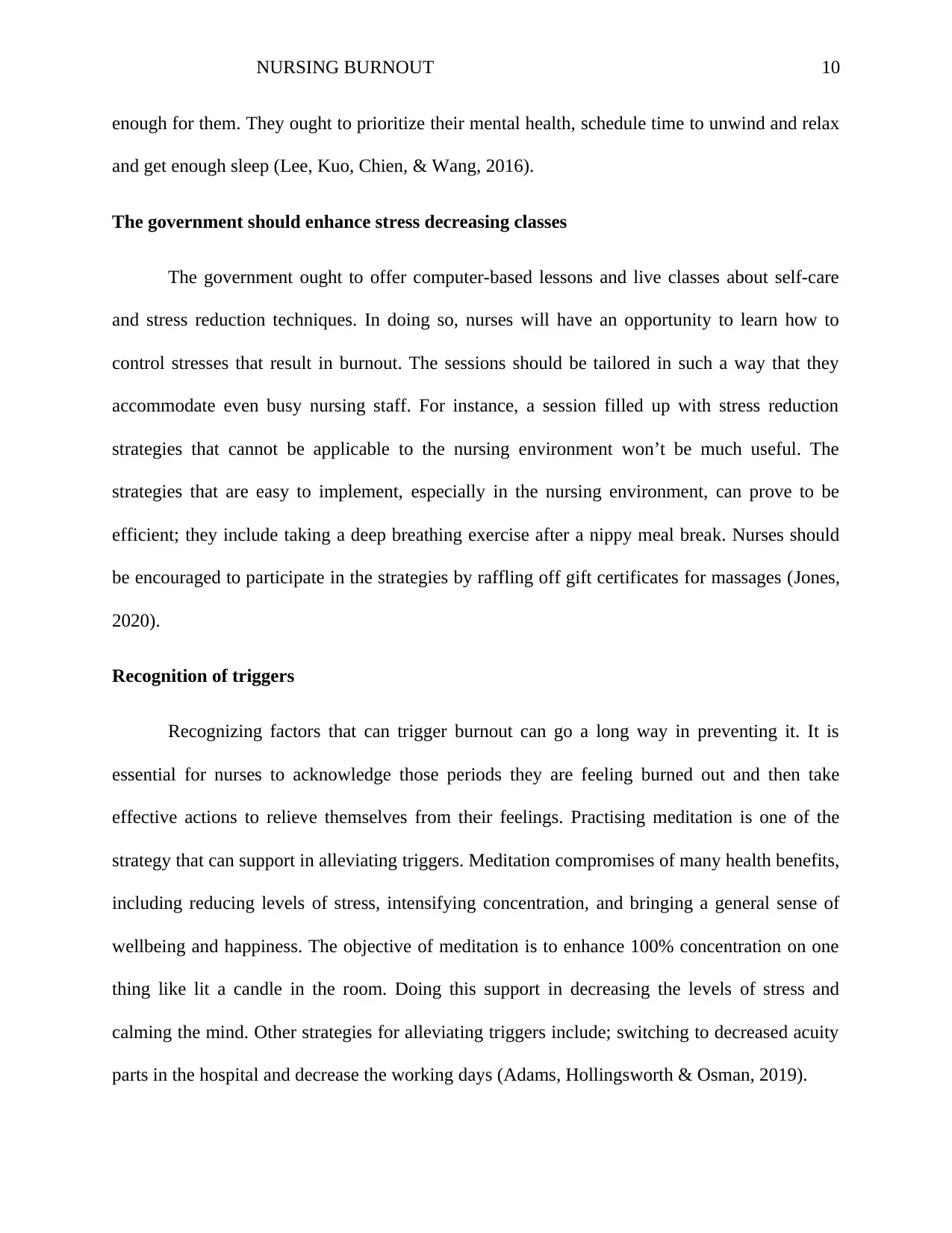
NURSING BURNOUT 10
enough for them. They ought to prioritize their mental health, schedule time to unwind and relax
and get enough sleep (Lee, Kuo, Chien, & Wang, 2016).
The government should enhance stress decreasing classes
The government ought to offer computer-based lessons and live classes about self-care
and stress reduction techniques. In doing so, nurses will have an opportunity to learn how to
control stresses that result in burnout. The sessions should be tailored in such a way that they
accommodate even busy nursing staff. For instance, a session filled up with stress reduction
strategies that cannot be applicable to the nursing environment won’t be much useful. The
strategies that are easy to implement, especially in the nursing environment, can prove to be
efficient; they include taking a deep breathing exercise after a nippy meal break. Nurses should
be encouraged to participate in the strategies by raffling off gift certificates for massages (Jones,
2020).
Recognition of triggers
Recognizing factors that can trigger burnout can go a long way in preventing it. It is
essential for nurses to acknowledge those periods they are feeling burned out and then take
effective actions to relieve themselves from their feelings. Practising meditation is one of the
strategy that can support in alleviating triggers. Meditation compromises of many health benefits,
including reducing levels of stress, intensifying concentration, and bringing a general sense of
wellbeing and happiness. The objective of meditation is to enhance 100% concentration on one
thing like lit a candle in the room. Doing this support in decreasing the levels of stress and
calming the mind. Other strategies for alleviating triggers include; switching to decreased acuity
parts in the hospital and decrease the working days (Adams, Hollingsworth & Osman, 2019).
enough for them. They ought to prioritize their mental health, schedule time to unwind and relax
and get enough sleep (Lee, Kuo, Chien, & Wang, 2016).
The government should enhance stress decreasing classes
The government ought to offer computer-based lessons and live classes about self-care
and stress reduction techniques. In doing so, nurses will have an opportunity to learn how to
control stresses that result in burnout. The sessions should be tailored in such a way that they
accommodate even busy nursing staff. For instance, a session filled up with stress reduction
strategies that cannot be applicable to the nursing environment won’t be much useful. The
strategies that are easy to implement, especially in the nursing environment, can prove to be
efficient; they include taking a deep breathing exercise after a nippy meal break. Nurses should
be encouraged to participate in the strategies by raffling off gift certificates for massages (Jones,
2020).
Recognition of triggers
Recognizing factors that can trigger burnout can go a long way in preventing it. It is
essential for nurses to acknowledge those periods they are feeling burned out and then take
effective actions to relieve themselves from their feelings. Practising meditation is one of the
strategy that can support in alleviating triggers. Meditation compromises of many health benefits,
including reducing levels of stress, intensifying concentration, and bringing a general sense of
wellbeing and happiness. The objective of meditation is to enhance 100% concentration on one
thing like lit a candle in the room. Doing this support in decreasing the levels of stress and
calming the mind. Other strategies for alleviating triggers include; switching to decreased acuity
parts in the hospital and decrease the working days (Adams, Hollingsworth & Osman, 2019).
Secure Best Marks with AI Grader
Need help grading? Try our AI Grader for instant feedback on your assignments.
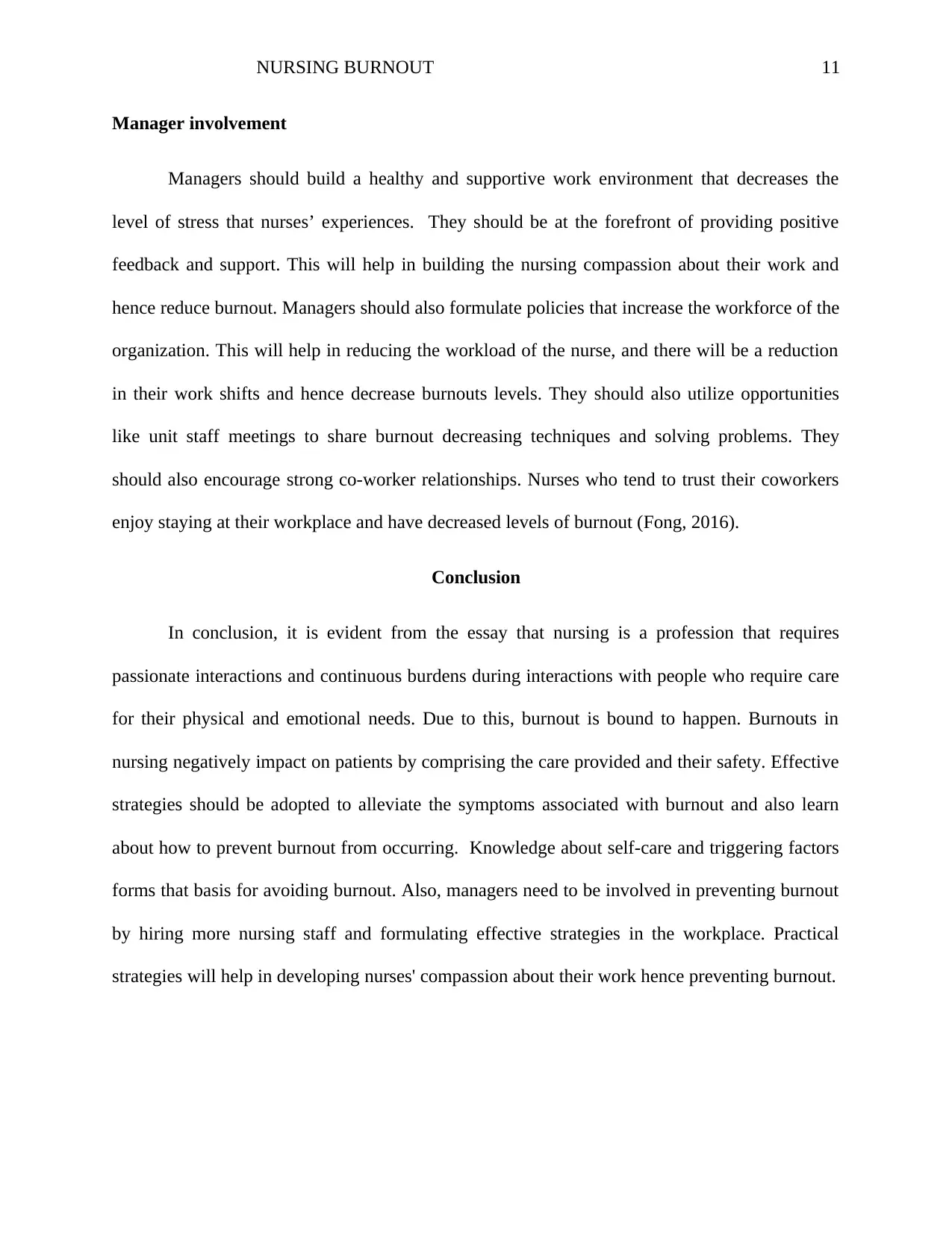
NURSING BURNOUT 11
Manager involvement
Managers should build a healthy and supportive work environment that decreases the
level of stress that nurses’ experiences. They should be at the forefront of providing positive
feedback and support. This will help in building the nursing compassion about their work and
hence reduce burnout. Managers should also formulate policies that increase the workforce of the
organization. This will help in reducing the workload of the nurse, and there will be a reduction
in their work shifts and hence decrease burnouts levels. They should also utilize opportunities
like unit staff meetings to share burnout decreasing techniques and solving problems. They
should also encourage strong co-worker relationships. Nurses who tend to trust their coworkers
enjoy staying at their workplace and have decreased levels of burnout (Fong, 2016).
Conclusion
In conclusion, it is evident from the essay that nursing is a profession that requires
passionate interactions and continuous burdens during interactions with people who require care
for their physical and emotional needs. Due to this, burnout is bound to happen. Burnouts in
nursing negatively impact on patients by comprising the care provided and their safety. Effective
strategies should be adopted to alleviate the symptoms associated with burnout and also learn
about how to prevent burnout from occurring. Knowledge about self-care and triggering factors
forms that basis for avoiding burnout. Also, managers need to be involved in preventing burnout
by hiring more nursing staff and formulating effective strategies in the workplace. Practical
strategies will help in developing nurses' compassion about their work hence preventing burnout.
Manager involvement
Managers should build a healthy and supportive work environment that decreases the
level of stress that nurses’ experiences. They should be at the forefront of providing positive
feedback and support. This will help in building the nursing compassion about their work and
hence reduce burnout. Managers should also formulate policies that increase the workforce of the
organization. This will help in reducing the workload of the nurse, and there will be a reduction
in their work shifts and hence decrease burnouts levels. They should also utilize opportunities
like unit staff meetings to share burnout decreasing techniques and solving problems. They
should also encourage strong co-worker relationships. Nurses who tend to trust their coworkers
enjoy staying at their workplace and have decreased levels of burnout (Fong, 2016).
Conclusion
In conclusion, it is evident from the essay that nursing is a profession that requires
passionate interactions and continuous burdens during interactions with people who require care
for their physical and emotional needs. Due to this, burnout is bound to happen. Burnouts in
nursing negatively impact on patients by comprising the care provided and their safety. Effective
strategies should be adopted to alleviate the symptoms associated with burnout and also learn
about how to prevent burnout from occurring. Knowledge about self-care and triggering factors
forms that basis for avoiding burnout. Also, managers need to be involved in preventing burnout
by hiring more nursing staff and formulating effective strategies in the workplace. Practical
strategies will help in developing nurses' compassion about their work hence preventing burnout.
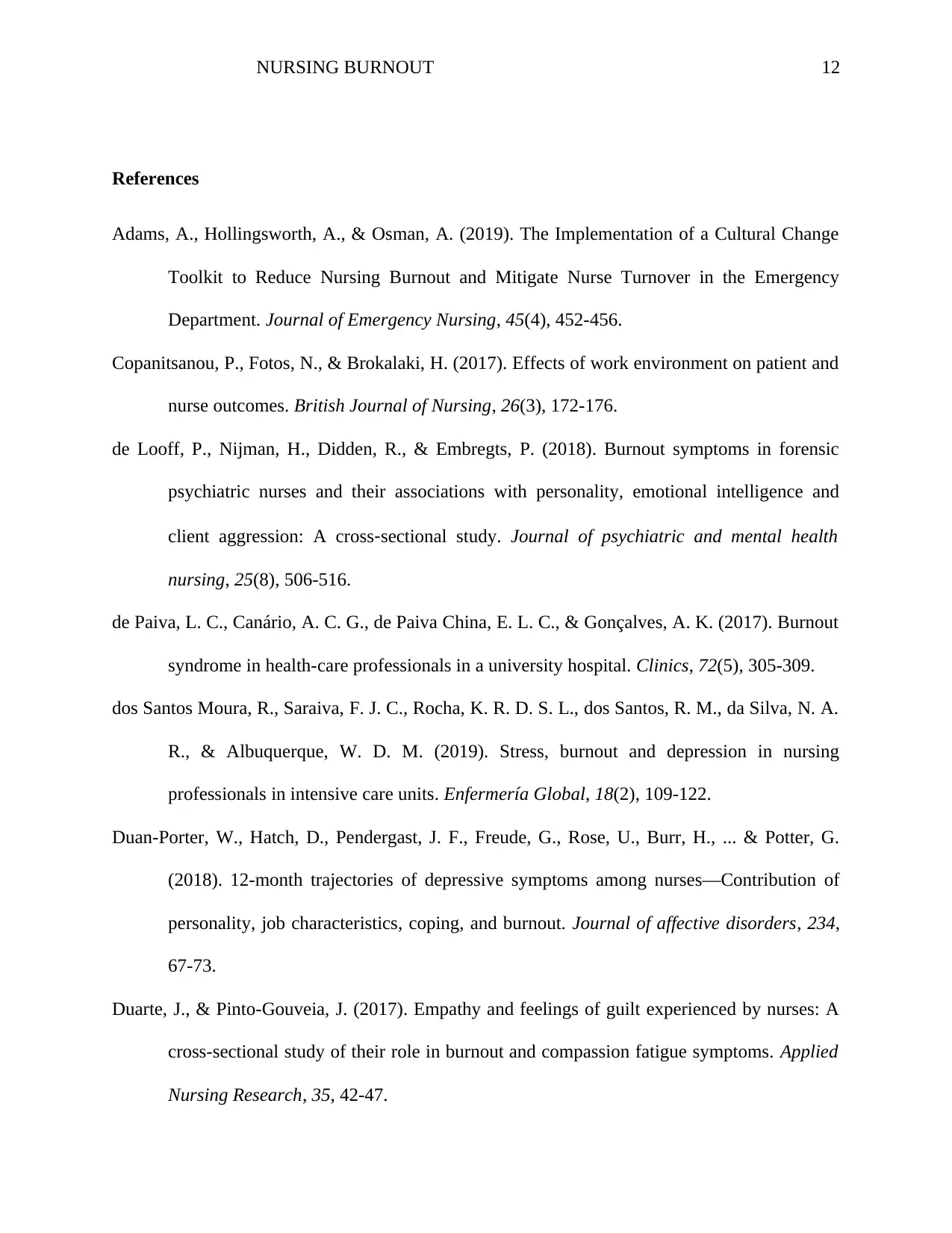
NURSING BURNOUT 12
References
Adams, A., Hollingsworth, A., & Osman, A. (2019). The Implementation of a Cultural Change
Toolkit to Reduce Nursing Burnout and Mitigate Nurse Turnover in the Emergency
Department. Journal of Emergency Nursing, 45(4), 452-456.
Copanitsanou, P., Fotos, N., & Brokalaki, H. (2017). Effects of work environment on patient and
nurse outcomes. British Journal of Nursing, 26(3), 172-176.
de Looff, P., Nijman, H., Didden, R., & Embregts, P. (2018). Burnout symptoms in forensic
psychiatric nurses and their associations with personality, emotional intelligence and
client aggression: A cross‐sectional study. Journal of psychiatric and mental health
nursing, 25(8), 506-516.
de Paiva, L. C., Canário, A. C. G., de Paiva China, E. L. C., & Gonçalves, A. K. (2017). Burnout
syndrome in health-care professionals in a university hospital. Clinics, 72(5), 305-309.
dos Santos Moura, R., Saraiva, F. J. C., Rocha, K. R. D. S. L., dos Santos, R. M., da Silva, N. A.
R., & Albuquerque, W. D. M. (2019). Stress, burnout and depression in nursing
professionals in intensive care units. Enfermería Global, 18(2), 109-122.
Duan-Porter, W., Hatch, D., Pendergast, J. F., Freude, G., Rose, U., Burr, H., ... & Potter, G.
(2018). 12-month trajectories of depressive symptoms among nurses—Contribution of
personality, job characteristics, coping, and burnout. Journal of affective disorders, 234,
67-73.
Duarte, J., & Pinto-Gouveia, J. (2017). Empathy and feelings of guilt experienced by nurses: A
cross-sectional study of their role in burnout and compassion fatigue symptoms. Applied
Nursing Research, 35, 42-47.
References
Adams, A., Hollingsworth, A., & Osman, A. (2019). The Implementation of a Cultural Change
Toolkit to Reduce Nursing Burnout and Mitigate Nurse Turnover in the Emergency
Department. Journal of Emergency Nursing, 45(4), 452-456.
Copanitsanou, P., Fotos, N., & Brokalaki, H. (2017). Effects of work environment on patient and
nurse outcomes. British Journal of Nursing, 26(3), 172-176.
de Looff, P., Nijman, H., Didden, R., & Embregts, P. (2018). Burnout symptoms in forensic
psychiatric nurses and their associations with personality, emotional intelligence and
client aggression: A cross‐sectional study. Journal of psychiatric and mental health
nursing, 25(8), 506-516.
de Paiva, L. C., Canário, A. C. G., de Paiva China, E. L. C., & Gonçalves, A. K. (2017). Burnout
syndrome in health-care professionals in a university hospital. Clinics, 72(5), 305-309.
dos Santos Moura, R., Saraiva, F. J. C., Rocha, K. R. D. S. L., dos Santos, R. M., da Silva, N. A.
R., & Albuquerque, W. D. M. (2019). Stress, burnout and depression in nursing
professionals in intensive care units. Enfermería Global, 18(2), 109-122.
Duan-Porter, W., Hatch, D., Pendergast, J. F., Freude, G., Rose, U., Burr, H., ... & Potter, G.
(2018). 12-month trajectories of depressive symptoms among nurses—Contribution of
personality, job characteristics, coping, and burnout. Journal of affective disorders, 234,
67-73.
Duarte, J., & Pinto-Gouveia, J. (2017). Empathy and feelings of guilt experienced by nurses: A
cross-sectional study of their role in burnout and compassion fatigue symptoms. Applied
Nursing Research, 35, 42-47.
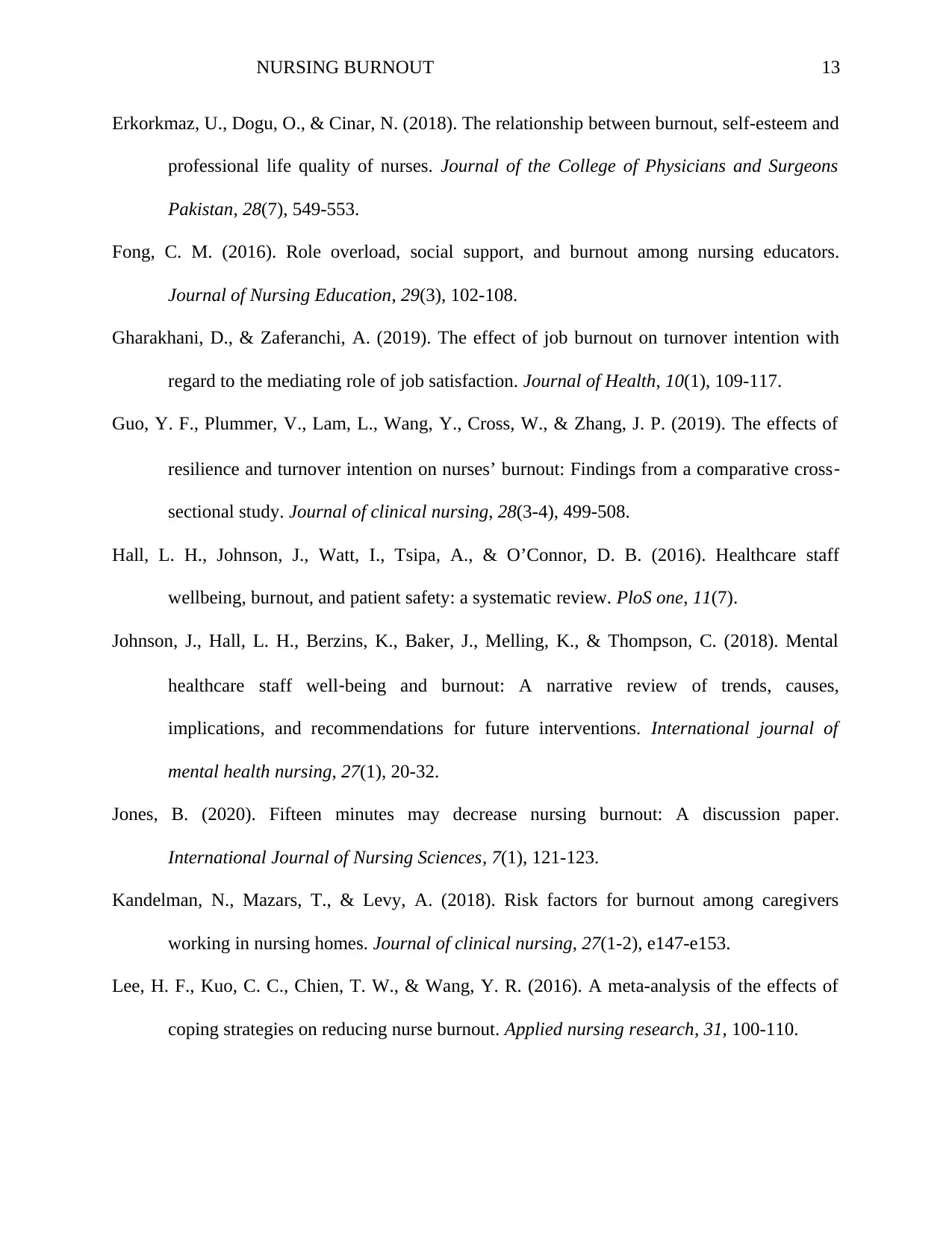
NURSING BURNOUT 13
Erkorkmaz, U., Dogu, O., & Cinar, N. (2018). The relationship between burnout, self-esteem and
professional life quality of nurses. Journal of the College of Physicians and Surgeons
Pakistan, 28(7), 549-553.
Fong, C. M. (2016). Role overload, social support, and burnout among nursing educators.
Journal of Nursing Education, 29(3), 102-108.
Gharakhani, D., & Zaferanchi, A. (2019). The effect of job burnout on turnover intention with
regard to the mediating role of job satisfaction. Journal of Health, 10(1), 109-117.
Guo, Y. F., Plummer, V., Lam, L., Wang, Y., Cross, W., & Zhang, J. P. (2019). The effects of
resilience and turnover intention on nurses’ burnout: Findings from a comparative cross‐
sectional study. Journal of clinical nursing, 28(3-4), 499-508.
Hall, L. H., Johnson, J., Watt, I., Tsipa, A., & O’Connor, D. B. (2016). Healthcare staff
wellbeing, burnout, and patient safety: a systematic review. PloS one, 11(7).
Johnson, J., Hall, L. H., Berzins, K., Baker, J., Melling, K., & Thompson, C. (2018). Mental
healthcare staff well‐being and burnout: A narrative review of trends, causes,
implications, and recommendations for future interventions. International journal of
mental health nursing, 27(1), 20-32.
Jones, B. (2020). Fifteen minutes may decrease nursing burnout: A discussion paper.
International Journal of Nursing Sciences, 7(1), 121-123.
Kandelman, N., Mazars, T., & Levy, A. (2018). Risk factors for burnout among caregivers
working in nursing homes. Journal of clinical nursing, 27(1-2), e147-e153.
Lee, H. F., Kuo, C. C., Chien, T. W., & Wang, Y. R. (2016). A meta-analysis of the effects of
coping strategies on reducing nurse burnout. Applied nursing research, 31, 100-110.
Erkorkmaz, U., Dogu, O., & Cinar, N. (2018). The relationship between burnout, self-esteem and
professional life quality of nurses. Journal of the College of Physicians and Surgeons
Pakistan, 28(7), 549-553.
Fong, C. M. (2016). Role overload, social support, and burnout among nursing educators.
Journal of Nursing Education, 29(3), 102-108.
Gharakhani, D., & Zaferanchi, A. (2019). The effect of job burnout on turnover intention with
regard to the mediating role of job satisfaction. Journal of Health, 10(1), 109-117.
Guo, Y. F., Plummer, V., Lam, L., Wang, Y., Cross, W., & Zhang, J. P. (2019). The effects of
resilience and turnover intention on nurses’ burnout: Findings from a comparative cross‐
sectional study. Journal of clinical nursing, 28(3-4), 499-508.
Hall, L. H., Johnson, J., Watt, I., Tsipa, A., & O’Connor, D. B. (2016). Healthcare staff
wellbeing, burnout, and patient safety: a systematic review. PloS one, 11(7).
Johnson, J., Hall, L. H., Berzins, K., Baker, J., Melling, K., & Thompson, C. (2018). Mental
healthcare staff well‐being and burnout: A narrative review of trends, causes,
implications, and recommendations for future interventions. International journal of
mental health nursing, 27(1), 20-32.
Jones, B. (2020). Fifteen minutes may decrease nursing burnout: A discussion paper.
International Journal of Nursing Sciences, 7(1), 121-123.
Kandelman, N., Mazars, T., & Levy, A. (2018). Risk factors for burnout among caregivers
working in nursing homes. Journal of clinical nursing, 27(1-2), e147-e153.
Lee, H. F., Kuo, C. C., Chien, T. W., & Wang, Y. R. (2016). A meta-analysis of the effects of
coping strategies on reducing nurse burnout. Applied nursing research, 31, 100-110.
Paraphrase This Document
Need a fresh take? Get an instant paraphrase of this document with our AI Paraphraser
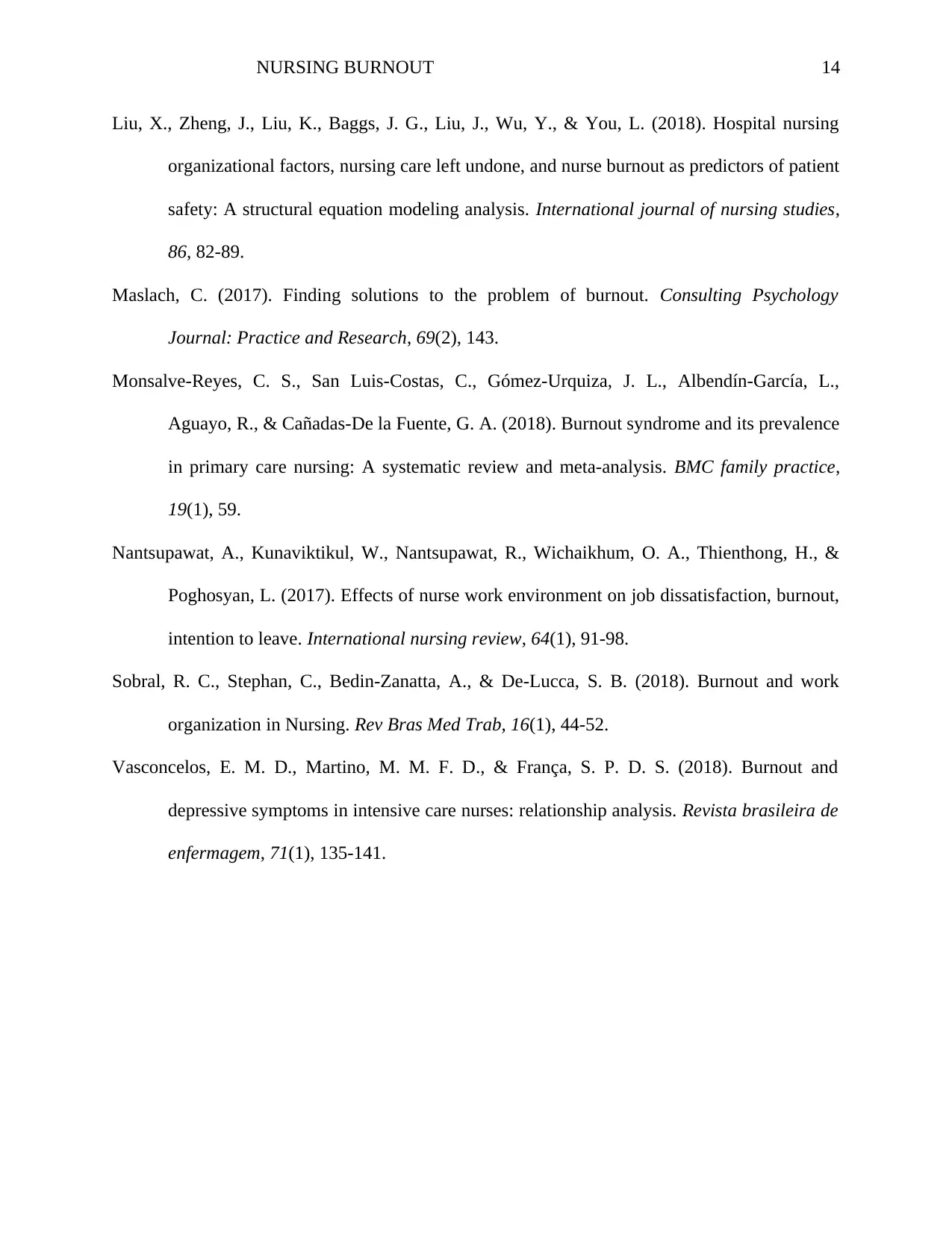
NURSING BURNOUT 14
Liu, X., Zheng, J., Liu, K., Baggs, J. G., Liu, J., Wu, Y., & You, L. (2018). Hospital nursing
organizational factors, nursing care left undone, and nurse burnout as predictors of patient
safety: A structural equation modeling analysis. International journal of nursing studies,
86, 82-89.
Maslach, C. (2017). Finding solutions to the problem of burnout. Consulting Psychology
Journal: Practice and Research, 69(2), 143.
Monsalve-Reyes, C. S., San Luis-Costas, C., Gómez-Urquiza, J. L., Albendín-García, L.,
Aguayo, R., & Cañadas-De la Fuente, G. A. (2018). Burnout syndrome and its prevalence
in primary care nursing: A systematic review and meta-analysis. BMC family practice,
19(1), 59.
Nantsupawat, A., Kunaviktikul, W., Nantsupawat, R., Wichaikhum, O. A., Thienthong, H., &
Poghosyan, L. (2017). Effects of nurse work environment on job dissatisfaction, burnout,
intention to leave. International nursing review, 64(1), 91-98.
Sobral, R. C., Stephan, C., Bedin-Zanatta, A., & De-Lucca, S. B. (2018). Burnout and work
organization in Nursing. Rev Bras Med Trab, 16(1), 44-52.
Vasconcelos, E. M. D., Martino, M. M. F. D., & França, S. P. D. S. (2018). Burnout and
depressive symptoms in intensive care nurses: relationship analysis. Revista brasileira de
enfermagem, 71(1), 135-141.
Liu, X., Zheng, J., Liu, K., Baggs, J. G., Liu, J., Wu, Y., & You, L. (2018). Hospital nursing
organizational factors, nursing care left undone, and nurse burnout as predictors of patient
safety: A structural equation modeling analysis. International journal of nursing studies,
86, 82-89.
Maslach, C. (2017). Finding solutions to the problem of burnout. Consulting Psychology
Journal: Practice and Research, 69(2), 143.
Monsalve-Reyes, C. S., San Luis-Costas, C., Gómez-Urquiza, J. L., Albendín-García, L.,
Aguayo, R., & Cañadas-De la Fuente, G. A. (2018). Burnout syndrome and its prevalence
in primary care nursing: A systematic review and meta-analysis. BMC family practice,
19(1), 59.
Nantsupawat, A., Kunaviktikul, W., Nantsupawat, R., Wichaikhum, O. A., Thienthong, H., &
Poghosyan, L. (2017). Effects of nurse work environment on job dissatisfaction, burnout,
intention to leave. International nursing review, 64(1), 91-98.
Sobral, R. C., Stephan, C., Bedin-Zanatta, A., & De-Lucca, S. B. (2018). Burnout and work
organization in Nursing. Rev Bras Med Trab, 16(1), 44-52.
Vasconcelos, E. M. D., Martino, M. M. F. D., & França, S. P. D. S. (2018). Burnout and
depressive symptoms in intensive care nurses: relationship analysis. Revista brasileira de
enfermagem, 71(1), 135-141.
1 out of 14
Related Documents
Your All-in-One AI-Powered Toolkit for Academic Success.
+13062052269
info@desklib.com
Available 24*7 on WhatsApp / Email
![[object Object]](/_next/static/media/star-bottom.7253800d.svg)
Unlock your academic potential
© 2024 | Zucol Services PVT LTD | All rights reserved.





